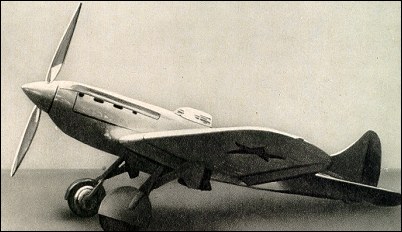|
| The TsKB-15 single-seat fighter prototype was a diminutive low-wing monoplane of slim configuration, powered by an imported 626kW Hispano-Suiza 12Y inline engine. With an inward-retracting undercarriage, it flew in September 1934 and was followed by the TsKB-19 with the M-100 (Soviet version of the Hispano engine). Armament comprised a 20mm cannon and four 7.62mm machine-guns. Production of a small number as the I-17-2 was reported, but it is not known if the type was used by first-line units. A third prototype (the TsKB-33) had reduced armament in an attempt to cut down weight and increase performance. The projected use of this version as a parasite fighter to be launched from a multiengined 'mother ship' was subsequently abandoned.
 | A three-view drawing (1280 x 878) |
| CREW | 1 |
| ENGINE | 1 x M-100, 550kW |
| WEIGHTS |
| Take-off weight | 1915 kg | 4222 lb |
| Empty weight | 1710 kg | 3770 lb |
| DIMENSIONS |
| Wingspan | 10.1 m | 33 ft 2 in |
| Length | 7.4 m | 24 ft 3 in |
| Wing area | 17.7 m2 | 190.52 sq ft |
| PERFORMANCE |
| Max. speed | 490 km/h | 304 mph |
| Cruise speed | 440 km/h | 273 mph |
| Ceiling | 9700 m | 31800 ft |
| Range w/max.fuel | 800 km | 497 miles |
| ARMAMENT | 1 x 20mm machine-guns, 4 x 7.62mm machine-guns, 100kg of bombs |
| Anonymous, 24.08.2022 17:58 Polikarpov intended this as the Soviet equivalent of the Hawker Hurricane, Supermarine Spitfire and Messerschmitt Me109. However, the Soviet Government chose not to develop this fighter further and to persist with production of the I-16. As a result, the Red Air Force did not get a fighter with a modern liquid-cooled engine, comparable to foreign counterparts, until 1941. Nevertheless, the I-17 prototype was displayed prominently at the Paris Aeronautical Salon in 1936, where foreign aeronautical experts apparently were more impressed with it than the Soviets were. reply | | sven, 09.09.2016 19:01 The huge fillet on the fuselage wing joint is likely to have caused unpleasant handling and contrary to appearances a lot of drag. reply | | CRoW56, e-mail, 09.09.2014 23:44 This aircraft has sweet lines and looks like it would be fast and handle well. Why was it abandoned? reply |
|
Do you have any comments?
|
| 
COMPANY
PROFILE
All the World's Rotorcraft
|







